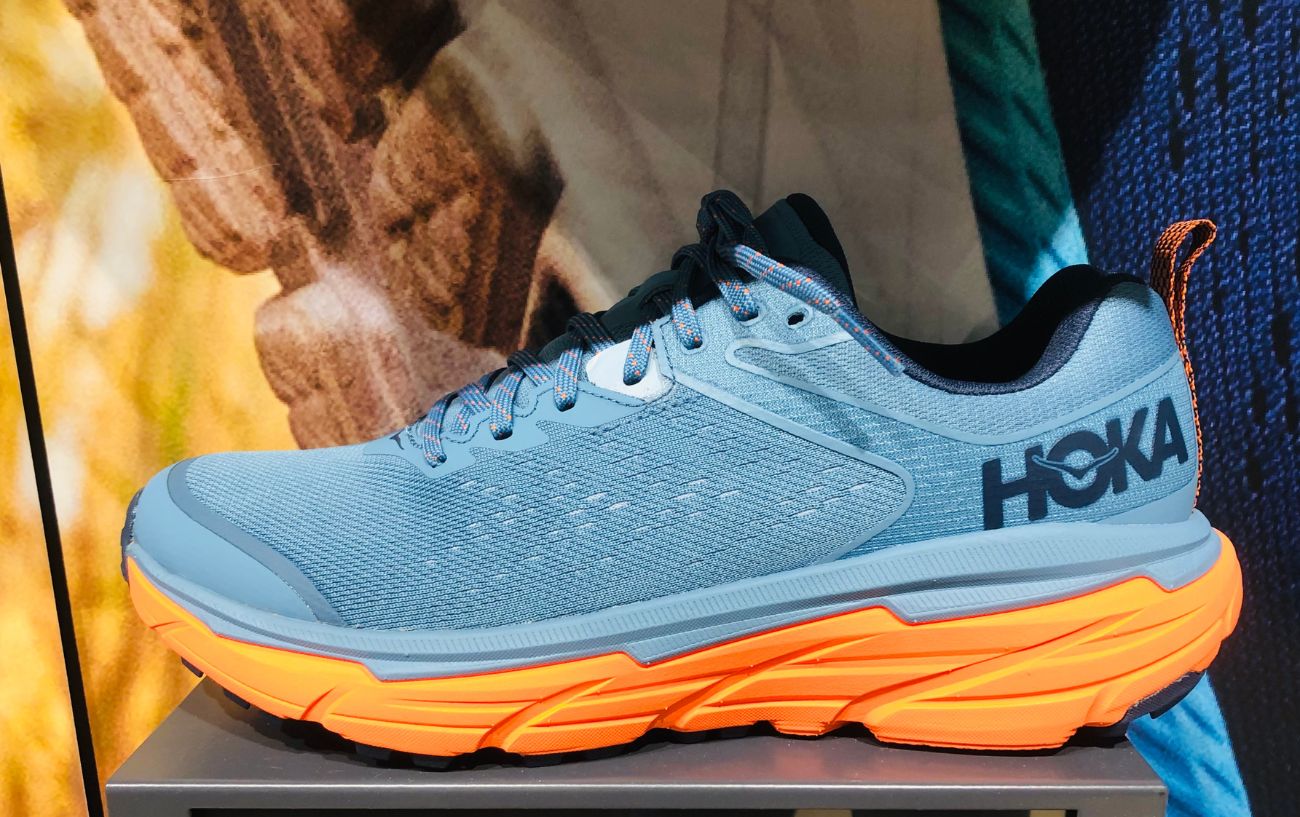When you’re in the market for a new pair of running shoes, it can be helpful to compare popular brands to help narrow down your search.
Companies such as Nike, New Balance, Brooks, and Saucony all design a wide range of running shoes with different levels of support and cushioning and for runners of different arch heights, training preferences (trail vs road), and experience levels.
Saucony vs HOKA running shoes is a fun comparison because the shoes are pretty different, yet there are also plenty of similarities.
So, what are the differences in features and fit between HOKA vs Saucony running shoes?
In this article, we will discuss the similarities and differences between HOKA vs Saucony running shoes to help you narrow down your shoe choices and find the best fit.
We will cover:
- HOKA vs Saucony Running Shoes: Main Differences
Let’s dive in!

HOKA vs Saucony Running Shoes: Main Differences
Both HOKA and Saucony running shoes tend to be narrower overall, fitting snugly in the heel and midfoot, compared with other brands such as New Balance and Brooks.
When comparing the shoe last—or shape of the shoe—between HOKA vs Saucony, the toe box tapers more dramatically in Saucony shoes rather than being slightly more squared off, so if you have a wide forefoot or a bunion, Saucony may be too narrow.
On the other hand, if you have a narrow foot, you might appreciate the narrower fit of Saucony vs HOKA shoes, particularly in the midfoot and forefoot.
Additionally, although HOKA running shoes are impressively lightweight for the amount of cushioning that these maximalist shoes offer, Saucony running shoes tend to be extremely lightweight and responsive.

Therefore, if you are looking for a fast shoe that helps you feel quick on your feet, you will love the energy return and feather-light feeling of Saucony vs HOKA running shoes.
One nice aspect about Saucony running shoes is that the models are frequently updated based on feedback from the Fit Tester program. This program allows everyday runners to test Saucony running shoes and provide their opinions and suggestions for future updates and modifications.
In general, compared to Saucony, most HOKA running shoes feature a wider toe box.
Saucony also manufactures casual shoes for everyday wear. HOKA mainly focuses on trail running shoes, road running shoes, hiking shoes, and a few models of workplace shoes or occupations where you stand on your feet all day.
Keep in mind that there may be specific models that are exceptions to these tendencies for either brand.

HOKA vs Saucony Running Shoes: Fit
Unlike some head-to-head comparisons of popular running shoe brands, the actual fit of Saucony vs HOKA running shoes is fairly similar. Both brands have a rather narrow fit, with a snug heel, midfoot, and fairly snug toe box.
For this reason, if you have a wider foot, particularly if you have a bunion, Morton’s neuroma, or metatarsalgia, you might not be able to get a comfortable fit with either Saucony or HOKA running shoes.
However, when comparing the two brands, you will find that the toe box, in particular, is wider in HOKA vs Saucony running shoes.
There are a few models that will come in a wide width. However, some runners find that the wide-width shoes from these brands fit more like a standard width compared to competitors like New Balance and Brooks.
Both HOKA and Saucony have shoe fit finders on their websites to help runners determine how to get a running shoe that fits well and feels comfortable. Here is the HOKA fit finder, and here is the Saucony one.
See also: Hoka vs On Cloud Shoes

While the fit might be fairly similar, there is quite a difference in the feel of HOKA vs Saucony running shoes.
HOKA shoes are maximalist running shoes, so they have a very thick midsole with plush cushioning. Although there are three different levels of cushioning used in HOKA running shoes, in general, HOKA shoes will feel more cushioned and soft than Saucony shoes.
In contrast, you will get more responsiveness and energy rebound with Saucony vs HOKA shoes.
There is also a difference in the average heel drop or heel-to-toe drop in the shoes.
Neither brand offers a zero-drop shoe, which Altra is known for.
However, most HOKA running shoes are low-heel drop running shoes, with an average heel-to-toe differential of 6 to 8 mm. This refers to the difference in stack height between the heel and the forefoot of the shoe.
Although the entire sole is nice and thick, there isn’t that much of a difference in the thickness between the heel and toe of the shoe. A lower-heel drop shoe is said to support a more natural running gait with a midfoot landing pattern.
In contrast, Saucony running shoes offer a range of heel drop measurements, anywhere from about 4 to 12 mm. However, most everyday trainers fall somewhere closer to 8 to 12 mm, which is standard for traditional running shoes.
Choosing HOKA vs Saucony, or specifically selecting Saucony running shoes with a lower heel-to-drop, may help better mimic natural running and may reduce the tendency to heel strike.

Saucony Vs HOKA Running Shoes: Cushioning
There are significant differences in the materials and resultant feel of the cushioning with HOKA vs Saucony running shoes.
Saucony primarily uses a proprietary PWRRUN technology for cushioning. It’s touted to be 25% lighter, more flexible, springier, and more durable than EVA foam.
Although Saucony running shoes do come in a variety of different cushioning levels, from essentially racing flats to more maximally cushioned shoes, the emphasis with Saucony cushioning is definitely on reducing the weight on the shoe to help you feel quick and light on your feet.
The cushioning is springy for excellent responsiveness, but it’s not particularly soft and plush.
Therefore, if you have joint issues or carry excess weight and prefer a greater level of cushioning, you will probably be better suited with HOKA vs Saucony running shoes, but if you want a lightweight trainer that helps you feel quick on your feet yet provide enough shock absorption, you may prefer Saucony vs HOKA shoes.

HOKA vs Saucony Running Shoes: Stability
Neither Saucony nor HOKA has particularly aggressive stability features in their running shoes that really aim to correct severe overpronation.
If you do have a tendency to overpronate significantly, you might be better served with motion-control shoes from a brand like New Balance or by using orthotics in your HOKA or Saucony running shoes.
Saucony enhances stability in running shoes with features such as a stiffer TPU heel plate and a medial post to control foot positioning, support the arch, and prevent excessive pronation.
HOKA running shoes are designed to be quite stable overall. They are built on a much wider platform, which essentially acts like a bucket seat to be more stable when you land, given the increased surface area.
There are also additional stability features in the HOKA models. These shoes feature a J-Frame and firmer foam on the medial side of the foot to prevent excessive pronation (rolling inward).

Saucony Vs HOKA Running Shoes: Durability
The durability of running shoes—or how long they will last—depends on the qualities of the materials used and the quality of construction of the shoes overall.
Both HOKA and Saucony make primarily premium running shoes, so all of the shoes are designed to be high-quality and long-lasting.
Saucony recommends replacing shoes every 400 miles, whereas HOKA running shoes are said to last closer to 500 miles. Therefore, you might get a little bit more durability from HOKA vs Saucony running shoes.
However, one thing to make note of is that HOKA trail shoes will last longer if you use them primarily on trails, but if you plan to do a lot of road running, you should select a road running model.
The durometer of the rubber outsole, or the density and ruggedness, varies between the shoes as well as the traction patterns. Wearing trail shoes on the roads will result in a faster breakdown.
There are additional factors that can affect the durability of any pair of running shoes that are not necessarily inherent to the shoes themselves.
These include things such as your body weight, arch height, running gait, foot strike pattern, whether or not you rotate your shoes, the terrain that you run on, how often you run in your shoes and for how long, and whether you keep your shoes dry and clean.

HOKA vs Saucony Running Shoes: Price
Both HOKA and Saucony running shoes are competitively and reasonably priced for the quality of the products, but Saucony running shoes tend to be a bit less expensive than HOKA shoes.
Most Saucony running shoes are in the $100 to $160 price range, whereas HOKA running shoes run closer to $120 to $180.
Overall, both HOKA and Saucony offer excellent running shoes for runners of different levels, training goals, and needs.
There isn’t a definitive winner in a Saucony vs HOKA matchup that will universally apply to every runner. Rather, you should consider your own biomechanical needs, fit preferences, and training style to determine which brand is a better fit for you.
If you prefer more cushioning, it is better to go with HOKA vs Saucony shoes, and if you want a lightweight and responsive running shoe, consider Saucony vs HOKA running shoes.
For more of our running shoe comparisons, check out:













